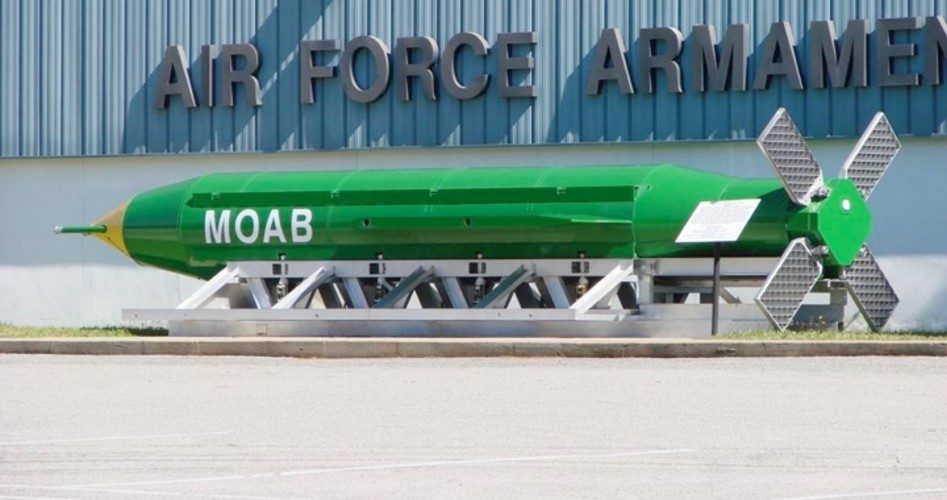
At approximately 7:00 p.m. local time on Thursday, April 13, the United States dropped its largest non-nuclear weapon on ISIS fighters in Afghanistan.
The bomb was dropped near Moman village in the Achin District of Nangarhar Povince in eastern Afghanistan, near the Pakistan border, to destroy tunnel complexes used by the ISIS faction there, known as ISIS-Khorasan, or ISIS-K.
The GBU-43 Massive Ordnance Air Blast (MOAB), often referred to as the “Mother of All Bombs,” is a conventional bomb over 30 feet long and weighing 22,600 pounds, including 18,700 pounds of high-explosive H-6 filling. The MOAB, which must be released out of the back of an MC-130H cargo plane as it is too large for bombers to carry, is detonated six feet above the ground, and has a blast yield equivalent to 11 tons of TNT and produces a crater over 900 feet across with a blast radius of over a mile. Anyone standing in the blast zone is vaporized.
Afghanistan’s ambassador to the United States, Hamdullah Mohib, told CNN that the bomb was dropped after fighting had intensified over the last week between U.S. Special Forces and Afghan troops against ISIS. The U.S. and Afghan forces were unable to advance because ISIS had mined the area with explosives, so the bomb was dropped to clear the tunnels, Mohib said.
As White House Press Secretary Sean Spicer told reporters in an April 13 press briefing,
At around 7:00 p.m. local time in Afghanistan last night, the United States military used a GBU-43 weapon in Afghanistan. The GBU-43 is a large, powerful and accurately delivered weapon. We targeted a system of tunnels and caves that ISIS fighters used to move around freely, making it easier for them to target U.S. military advisors and Afghan forces in the area.
The United States takes the fight against ISIS very seriously. And in order to defeat the group, we must deny them operational space, which we did. The United States took all precautions necessary to prevent civilian casualties and collateral damage as a result of the operation. Any further details, I would refer you to the Department of Defense on that.
According to CNN, Afghan officials claim that the strike killed 36 ISIS fighters. Although the U.S. government officially says that there were no civilian casualties, an Afghan official from Nangarhar told The Guardian that a teacher and his young son had been killed.
Villagers in nearby towns felt the blast. CNN reports that a local resident living around 1.5 miles from the blast said he heard an “extremely loud boom that smashed the windows of our house…. We were all scared and my children and my wife were crying. We thought it had happened right in front of our house.” Another Afghan man, 46-year-old Abdul, who lives nearly two miles from the site, described the thick cloud of dust that formed after the deafening blast: “We were unable to see each other at home because of the excessive dust inside the room…. I was feeling that boom ’til the morning.”
While some analysts asked whether President Trump himself ordered the strike, Trump told reporters on April 13, “Everybody knows exactly what happened. So, what I do is I authorize my military…. We have given them total authorization.”
According to the U.K. Daily Mail, news reports suggest that General John Nicholson, commander of U.S. forces in Afghanistan, made the decision to drop the MOAB. Nicholson said in a statement about ISIS, “As ISIS-K’s losses have mounted, they are using IEDs, bunkers and tunnels to thicken their defense…. This is the right munition to reduce these obstacles and maintain the momentum of our offensive against [ISIS-K]…. The strike was designed to minimize the risk to Afghan and U.S. Forces conducting clearing operations in the area while maximizing the destruction of ISIS-K fighters and facilities.”
Javid Kohistani, a military analyst in Kabul, questioned the wisdom of such an attack. “Isis has killed thousands of innocent Iraqis and Syrians. Why are they not dropping the bomb there? Why use it in Nangarhar?” he told The Guardian.
To eradicate terrorism in Afghanistan, he said, the United States should target the source of its finances and support: “The Trump government should put more pressure on Pakistan.”
A better solution would be for the United States, and Western nations in general, to cease their meddling in the Middle East, where conflict has been going on for more than a century and which has become particularly egregious post-WWII. As The New American and others have pointed out repeatedly, the radical Islamic terrorism in recent years is largely a result of interventionist foreign policies of Western nations attempting to reshape the Middle East. A constitutional foreign policy of non-intervention, using the military only to defend our country against attack, and only going to war upon a declaration by the U.S. Congress, would be much better for our country.
Photo: GBU-43/B on display at the Air Force Armament Museum, Eglin Air Force Base, Florida.



